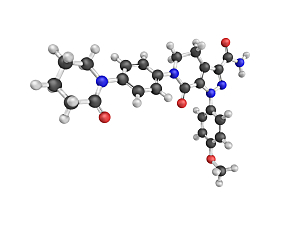Several direct oral anticoagulants (DOACs) are available to prevent recurrent thromboembolism in patients with venous thromboembolism (VTE). All have been demonstrated to be safe, effective, and comparable to warfarin, for short-term treatment. For extended treatment, there’s limited evidence about their comparative effectiveness.
Researchers at Brigham and Women’s Hospital recently published in JAMA a nationwide U.S. cohort study of patients who extended their anticoagulant treatment beyond the initial 90-day treatment after hospitalization for VTE. Extended treatment with apixaban, compared with warfarin, was associated with a modestly lower rate of hospitalization for recurrent VTE but no significant reduction in hospitalization for major bleeding.
The report’s authors are Ajinkya Pawar, PhD, who was a research specialist in the Division of Pharmacoepidemiology and Pharmacoeconomics of the Department of Medicine during the course of the study, Katsiaryna Bykov, PharmD, ScD, an assistant professor of Medicine in that division, and colleagues. The study was funded by the Patient-Centered Outcomes Research Institute.
Methods
The retrospective cohort study used the fee-for-service Medicare database for 2009–2017 and two large commercial health insurance databases for 2004–2018. The researchers examined pharmacy dispensing of the three oral anticoagulants most commonly used in the U.S. to treat VTE: apixaban, rivaroxaban, and warfarin.
64,642 adults initiated oral anticoagulation after VTE discharge during 2010–2018 and continued treatment for more than 90 days. The researchers assigned treatment groups based on the medications dispensed after the initial 90 days: 9,167 patients received apixaban, 12,468 received rivaroxaban, and 43,007 received warfarin.
Because the study wasn’t randomized, the team used propensity score weighting to reduce bias due to confounding. That process resulted in three treatment groups that were balanced on demographics, characteristics of the index event (deep vein thrombosis vs. pulmonary embolism), comorbidities, other medications used at baseline, healthcare utilization, and other important covariates. Follow-up started after the initial 90-day treatment period, and patients were censored if they stopped medication or switched to another anticoagulant.
Primary Outcomes
One of the co-primary outcome measures was hospitalization for recurrent VTE:
- Apixaban vs. warfarin—Significantly lower risk with apixaban (pooled weighted HR, 0.69; 95% CI, 0.49–0.99)
- Rivaroxaban vs. warfarin—No significant difference
- Apixaban vs. rivaroxaban—No significant difference
The other co-primary outcome was hospitalization for intracranial bleeding, gastrointestinal bleeding, or other major bleeding:
- Apixaban vs. warfarin—No significant difference
- Rivaroxaban vs. warfarin—No significant difference
- Apixaban vs. rivaroxaban—No significant difference
Secondary Outcomes
The two secondary measures were all-cause mortality and a composite of the primary outcome measures. There were no significant differences in risk between warfarin and either DOAC and no differences between the two DOACs.
Sensitivity Analyses
The results were consistent in sensitivity analyses that evaluated extended treatment after 180 days, and analyses where patients were not censored on treatment change (intention-to-treat approach).
Applying the Findings to Practice
This study provides evidence that when treatment for VTE is extended past 90 days, the choice of apixaban may be preferable to warfarin.
No definitive conclusions should be drawn about the relative benefits and risks of rivaroxaban compared with warfarin or apixaban. There was limited statistical power to detect small but clinically important differences between these treatments.
